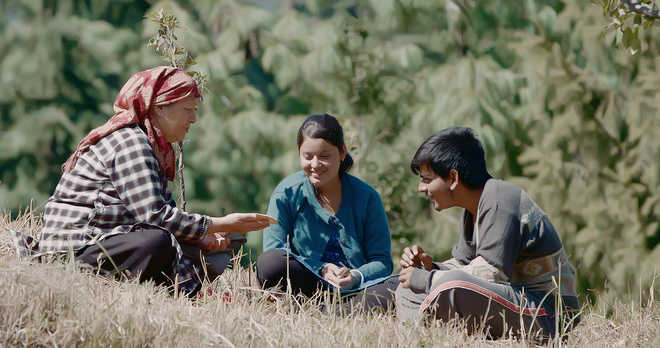Sarika Sharma
Like all of us, Ajay Saklani too grew up on stories. These were stories about his people, his culture, his village. And when it was time for him to tell a story, he wanted it to be about his own people, in his own language. The story is now called Saanjh, a film about the ageing parents living alone in villages while the young generation has migrated to the cities. This would also be the first-ever Pahari film from Himachal to travel to a film festival in the US.
A documentary filmmaker, Saklani had written a song ‘Puchhe amma meri, auna kade ghare jo’ (Mother asks me, when will you return home) talking about the loneliness of parents back home in villages. He was contemplating recording a music video when he felt the song wouldn’t be enough to describe the actual scenario. It was then that he decided to make a film.
The film’s cast and crew is mostly from Himachal. However, there are big names like singer Mohit Chauhan and actor Asif Basra too. As Saanjh travels to the Borrego Springs Film Festival in the US next month, it becomes the first film from the valley of gods to be screened at such a platform.
One wonders what made him take the risk of making a Pahari film when there is no industry in the state to talk of. Saklani is aware; for him, making the movie in Pahari was a conscious decision. “The films made here so far have been a good try, but without any technical and creative know-how and understanding. Himachal is in need of a cinema that can take us further and inspire the youth to accept our language and culture,” he says.
And audience? Is there enough? “In Himachal, I believe, there are only two different languages: one in the upper Himachal i.e. Kinnaur, Lahaul & Spiti and Pangi and some parts of Shimla district. The rest of Himachal speaks the same language, but in different tones. Almost 70-80 per cent words are the same in the rest of Himachal,” says Saklani insisting that unless Himachal produces quality content, this question will keep coming up again and again.
As for Saanjh, he doesn’t see language as a barrier. He feels a film should be independent of language. “Rather, it should be visually strong,” he says. He insists that Saanjh is a visually strong film and can be understood by anyone who can understand any Himachali dialect, Punjabi, Dogri, and even Hindi.
Saklani took the film to the NFDC Film Bazaar, Goa, last month and is working on a theatrical release in six north Indian states. “We want to release it in Pahari. However, if response from international audience is good, we would want to release it in other states as well.” Borrego Springs Film Festival is just the beginning.
Unlock Exclusive Insights with The Tribune Premium
Take your experience further with Premium access.
Thought-provoking Opinions, Expert Analysis, In-depth Insights and other Member Only Benefits
Already a Member? Sign In Now











